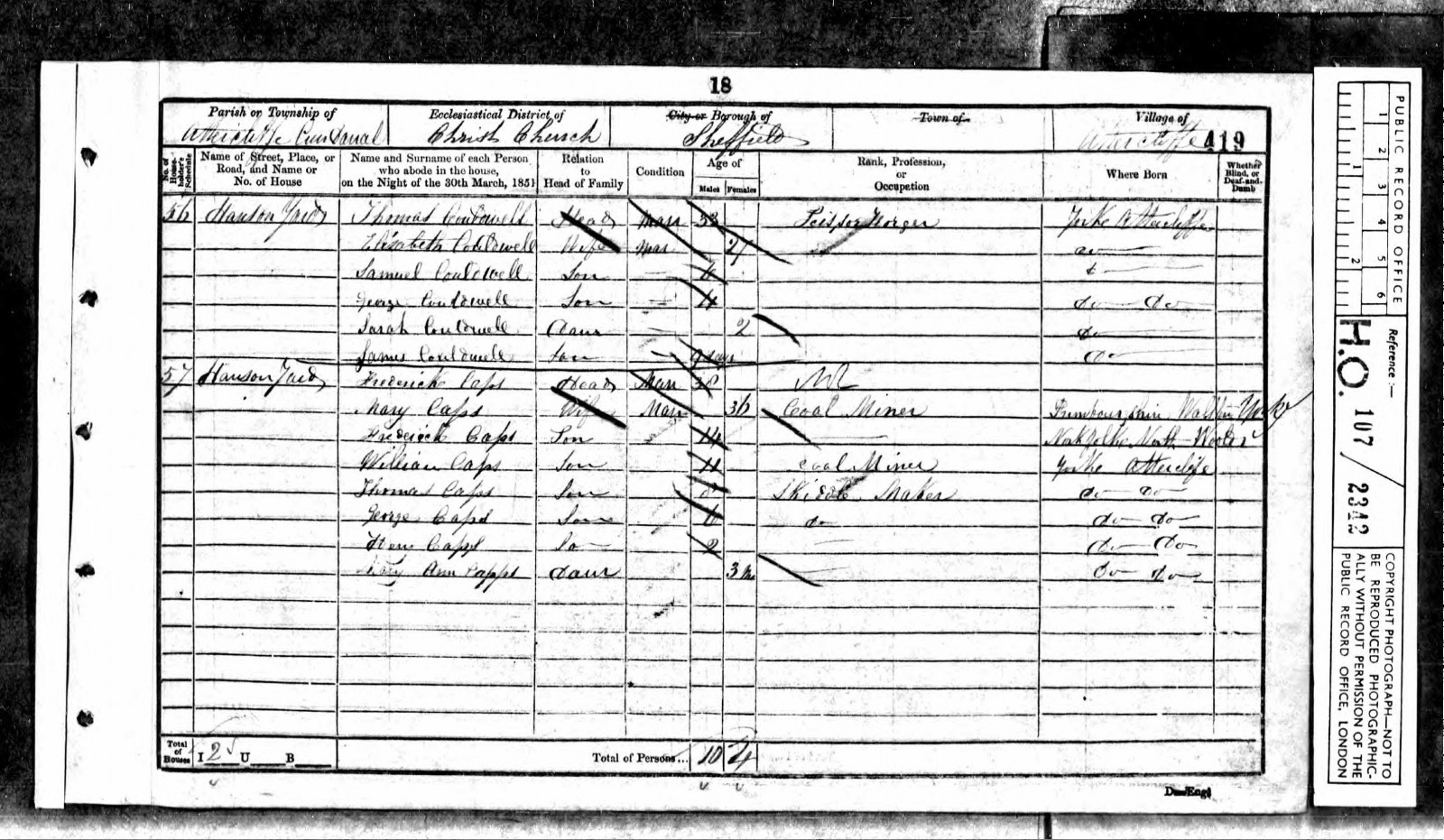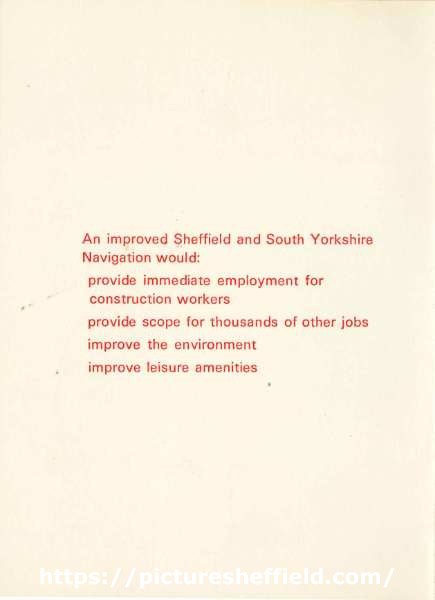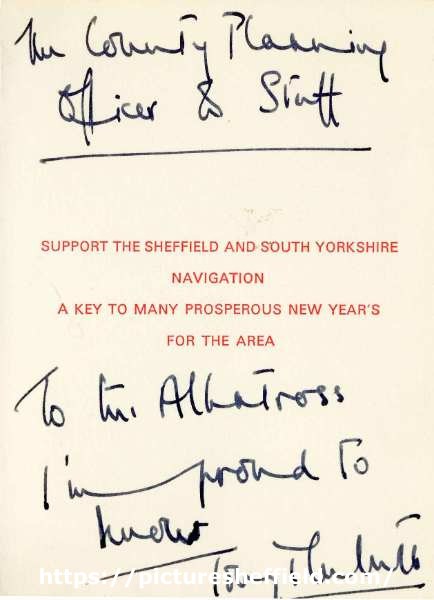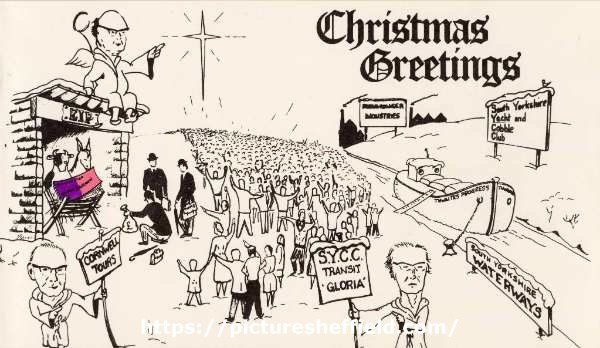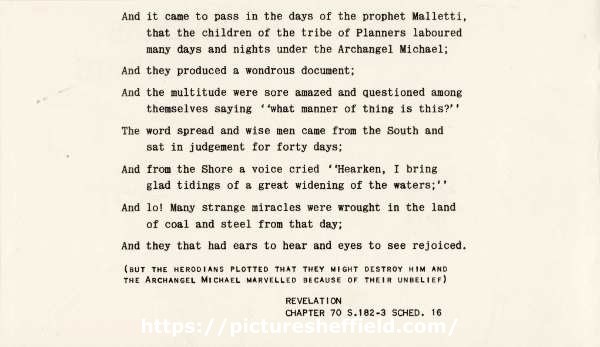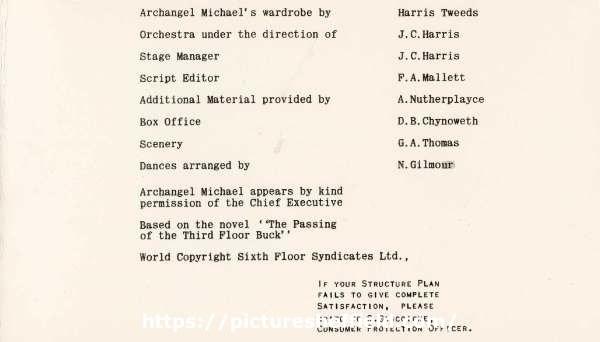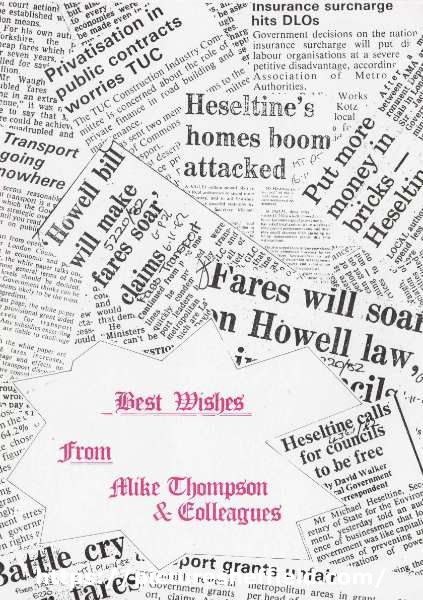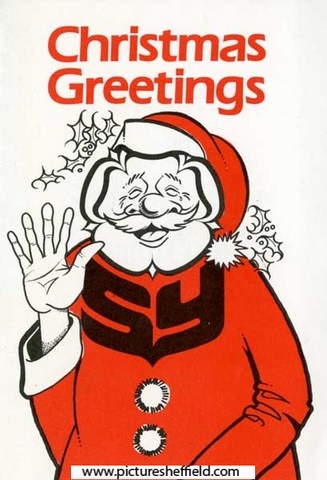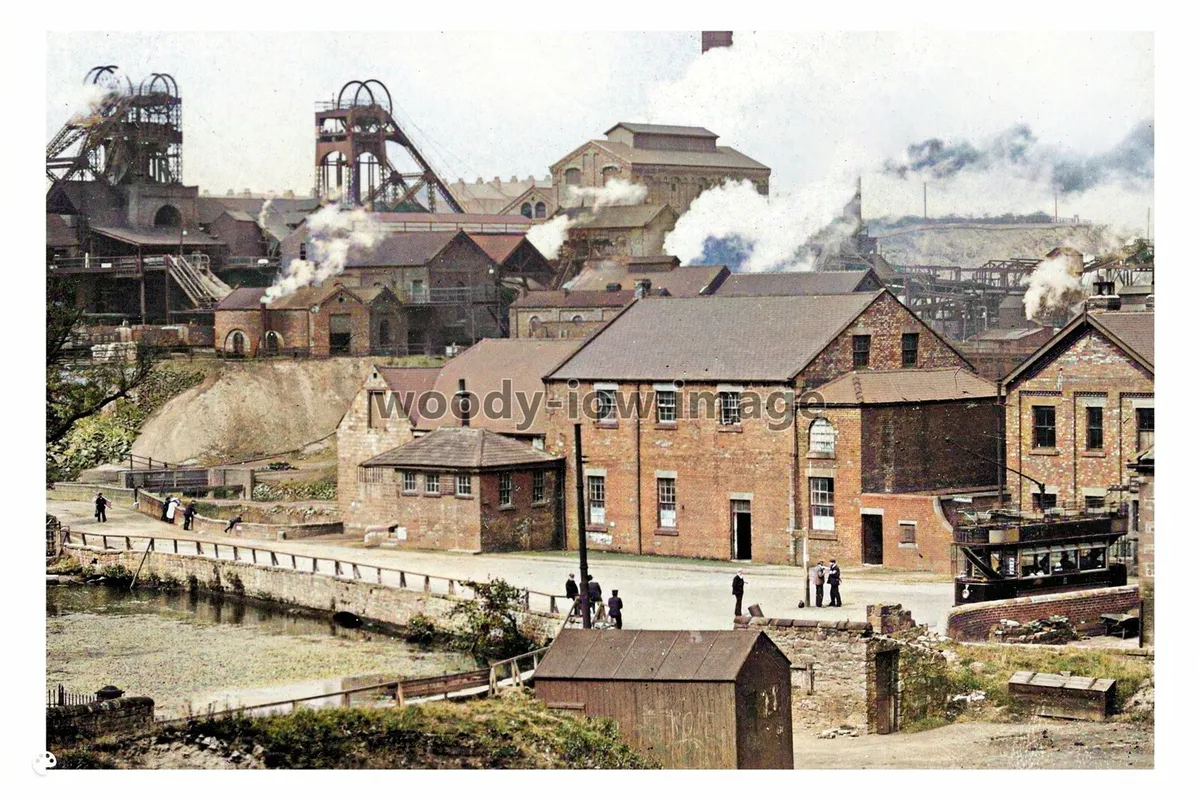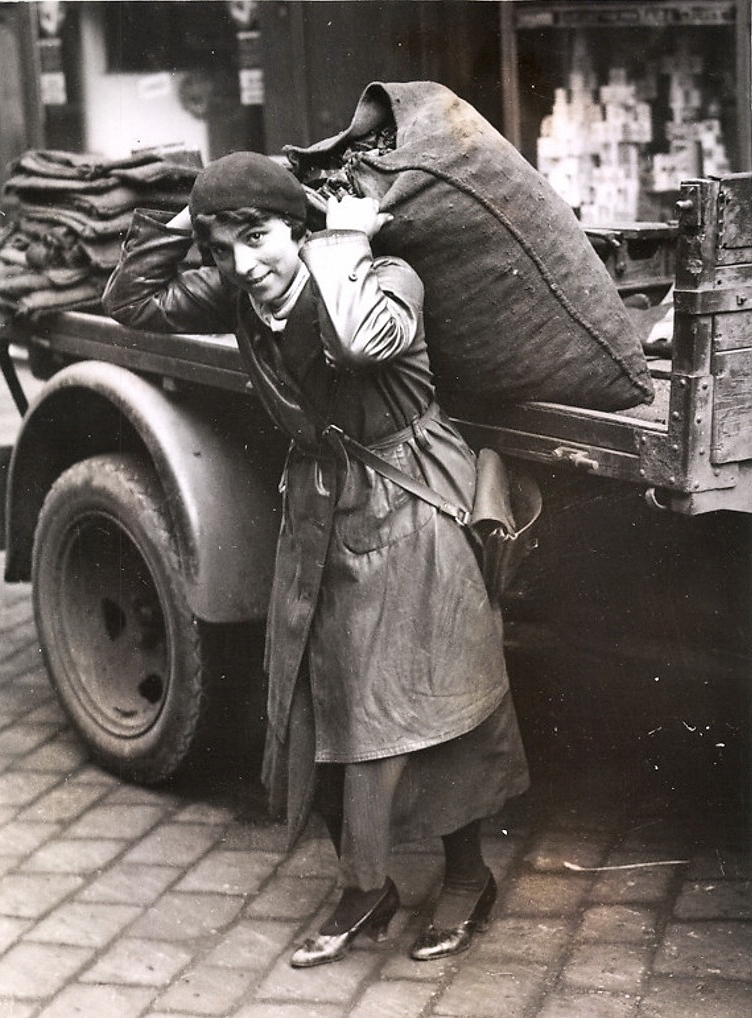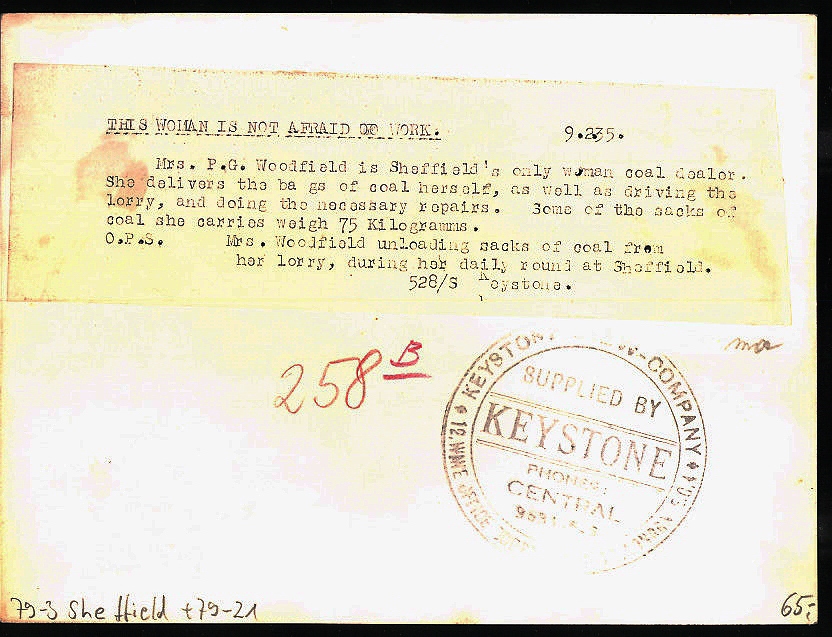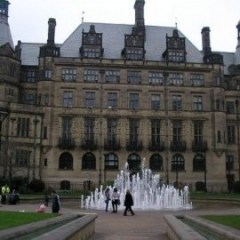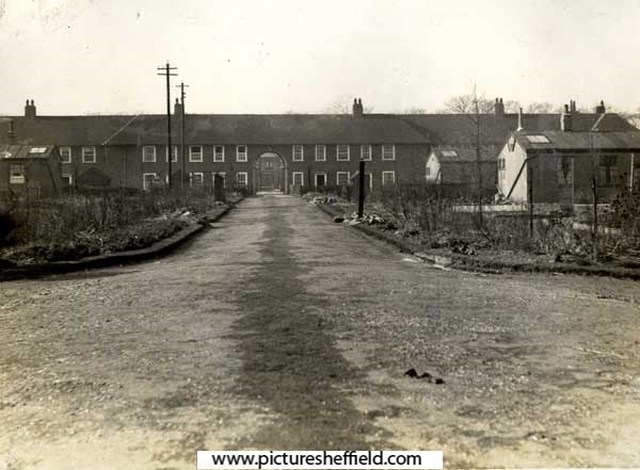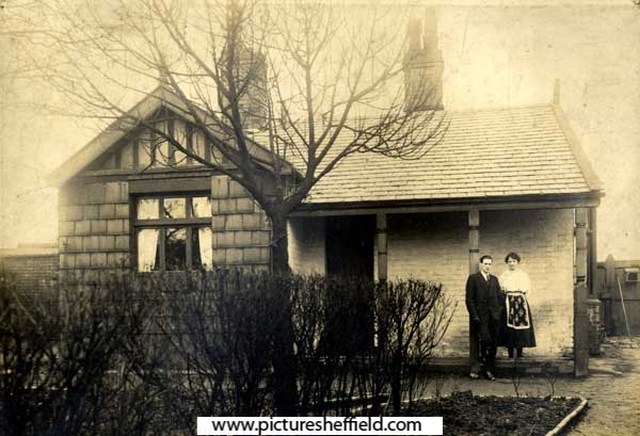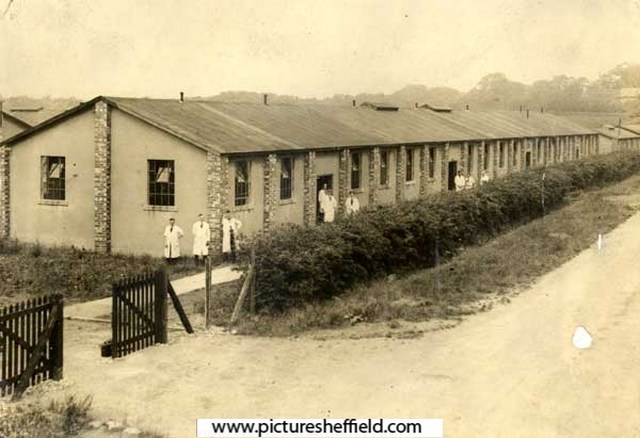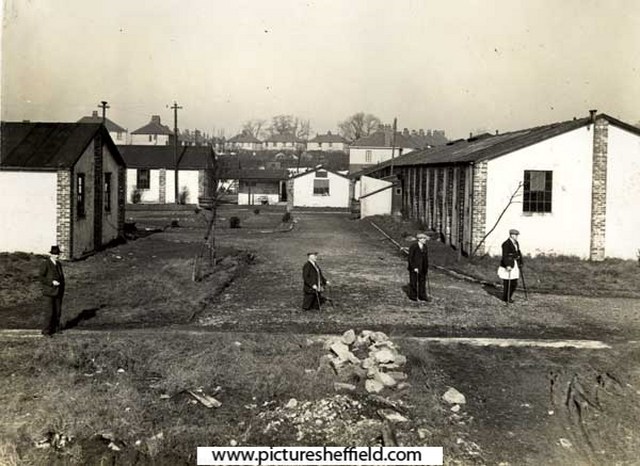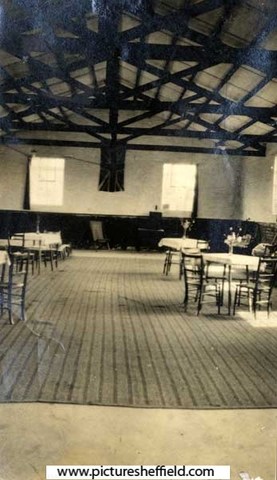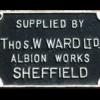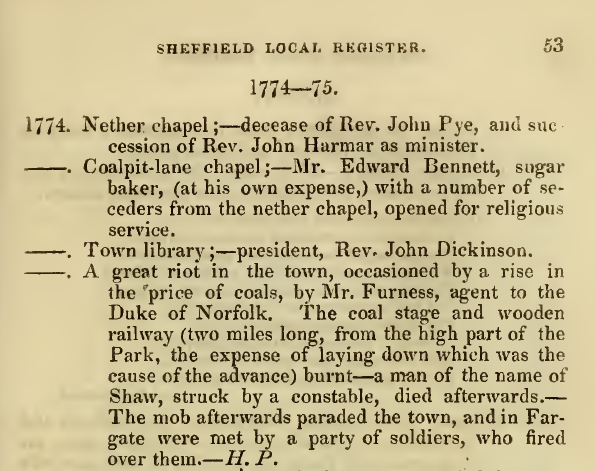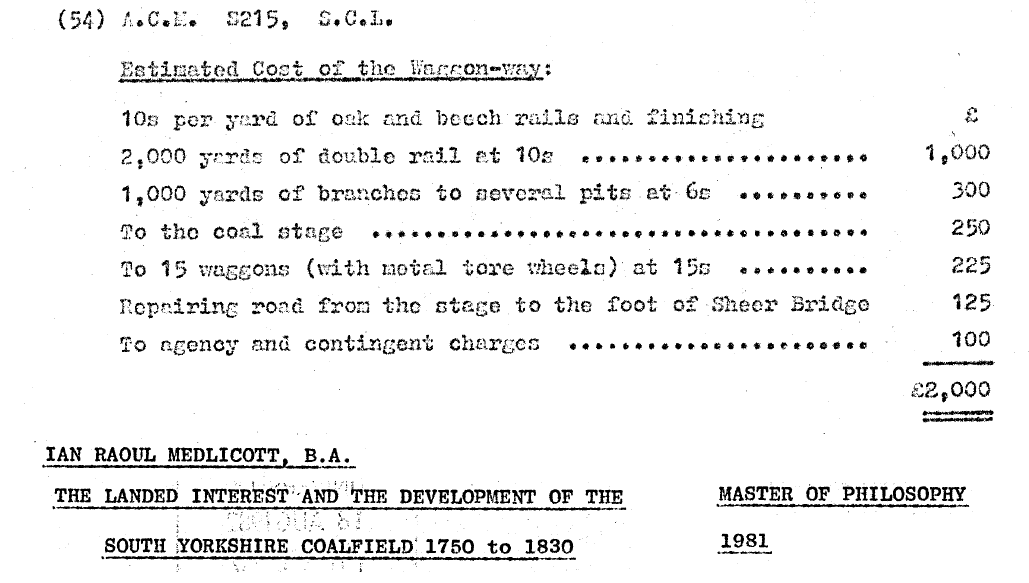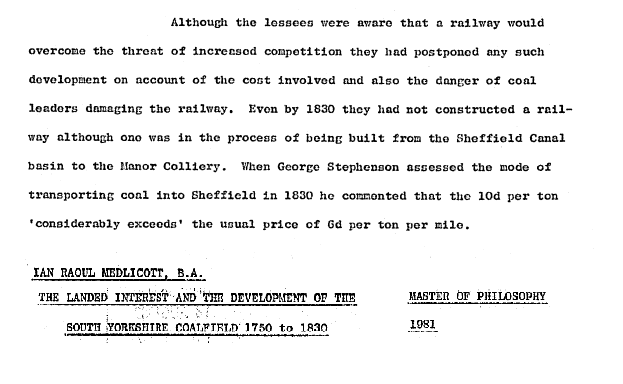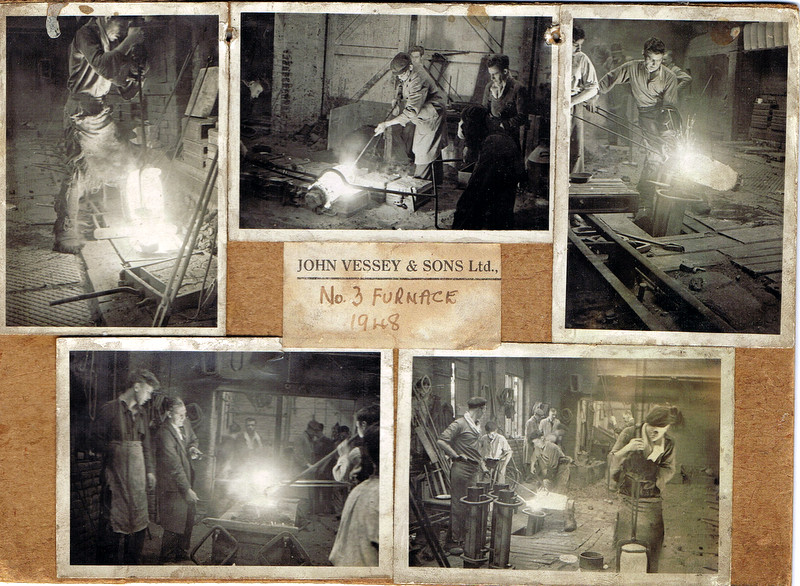Search the Community
Showing results for 'coal pit lane'.
-
I cannot find evidence of drift mines or old pitheads but can north side of High Storrs RD
-
My granddad Robert sustained a broken spine as a result of being crushed between a full tub of coal and the pit side of Nunnerley colliery on 14 May 1947. He died in the Sheffield Royal Infirmary on the 16th. The coroner for the City of Sheffield raised an inquest on the 17th. Would anyone know if I can see a copy of this? Also, would grandma have received any compensation? Many thanks, Derek.
-
South Yorkshire County Council Christmas Cards. South Yorkshire County Council Christmas Card - South Yorkshire Waterways. arc07248arc7249arc07250 An improved Sheffield and South Yorkshire Navigation would: Provide immediate employment forconstruction workers Provide scope for thousands of other jobs Improve the environment Improve leisure amenities Support the Sheffield and South Yorkshire Navigation - A key to many prosperous New Year’s for the area. Original at Sheffield City Archives: SYCC/PL/31/13 (altrefno: SYCC CB 681). South Yorkshire County Council Christmas Card - South Yorkshire Waterways / County Structure Plan. arc07245arc07246arc07247 Includes reference to Thwaites Progress (Roy Thwaites was Deputy Leader of the County Council, 1979-1980 and Leader, 1980-1986), Cornwell Tours (John Cornwell was Deputy Leader, 1981-1986), SYCC Transit 'Gloria', South Yorkshire Yacht and Cobble Club, EIP, and (inside the stable) Structure Plan Written Statement. And it came to pass in the days of the prophet Malletti, That the children of the tribe of Planners laboured Many days and nights under the Archangel Michael; And they produced a wondrous document; And the multitude were sore amazed and questioned among themselves saying ''What manner of thing is this?'' The word spread and wise men came from the South and sat in judgement for forty days; And from the Shore a voice cried ''Hearken, I bring glad tidings of A great widening of the waters;'' And lo! Many strange miracles were wrought in the land of coal and steel from that day; And they that had ears to hear and eyes to see rejoiced. (But the Herodians plotted that they might destroy him and the archangel Michael marvelled because of their unbelief) Revelation chapter 70 s.182-3 sched 16. Archangel Michael's wardrobe by Harris Tweeds Orchestra under the direction of J. C. Harris Stage Manager J.C. Harris. Script Editor F. A. Mallett. Additional Material provided by A. Nutherplayce. Box Office D. B. Chynoweth. Scenery G. A. Thomas. Dances arranged by N. Gilmour. Archangel Michael appears by kind permission of the Chief Executive. Based on the novel '"The Passing of the Third Floor Buck". World Copyright Sixth Floor Syndicates Ltd. If your structure plan fails to give complete satisfaction, please write to S. Gascoigne, Consumer Protection Officer. Original at Sheffield City Archives: SYCC/PL/31/13 (altrefno: SYCC CB 681) South Yorkshire County Council Christmas Card - best wishes from Mike Thompson and Colleagues. arc07243 Original at Sheffield City Archives: SYCC/PL/31/13 (altrefno: SYCC CB 681) arc07244 This card depicts the Prime Minister, Margaret Thatcher, and the Secretary of State for the Environment, Michael Heseltine, carving up a Local Government Pudding. This related to the Government's plans to abolish Metropolitan County Councils in 1986. Original at Sheffield City Archives: SYCC/PL/31/13 (altrefno: SYCC CB 681). South Yorkshire County Council - final Christmas Card. 1985.arc05252 Image from Sheffield Local Studies Library: MP Folder 2.
-

What does "main" mean in a colliery name ?
Lysanderix replied to JS2021's topic in Sheffield History Chat
My finding of the Dore Colliery came about whilst I was researching the early days of the NCB….and Dore was listed in an official publication detailing all the coal mining companies, including those which were dormant. -

What does "main" mean in a colliery name ?
Ponytail replied to JS2021's topic in Sheffield History Chat
Rotherham Main Colliery. https://www.nmrs.org.uk/mines-map/coal-mining-in-the-british-isles/yorkshire-coalfield/sheffield/rotherhammain/ https://en.m.wikipedia.org/wiki/Rotherham_Main_Colliery Rotherham Main Colliery at Canklow. Dalton Main Colliery Ltd. https://en.m.wikipedia.org/wiki/Dalton_Main_Collieries_Ltd. Aldwarke Main Colliery https://en.m.wikipedia.org/wiki/Aldwarke_Main_Colliery Aldwarke Main Colliery Explosion 1875. https://www.nmrs.org.uk/mines-map/accidents-disasters/yorkshire/aldwarke-main-colliery-explosion-rotherham-1875/ Aldwarke Main Colliery Accident 1904. https://www.nmrs.org.uk/mines-map/accidents-disasters/yorkshire/aldwarke-main-colliery-accident-rotherham-1904/ -

What does "main" mean in a colliery name ?
Ponytail replied to JS2021's topic in Sheffield History Chat
Maltby Colliery, formed as Maltby Main Colliery Co. Ltd. 1907. https://www.nmrs.org.uk/mines-map/coal-mining-in-the-british-isles/yorkshire-coalfield/sheffield/maltby-colliery/ -
From the reverse: THIS WOMAN IS NOT AFRAID TO WORK Mrs. P.G. Woodfield is Sheffield's only woman coal dealer. She delivers the bags of coal herself, as well as driving the lorry, and doing the necessary repairs. Some of the sacks of coal she delivers weigh 75 Kilogramms. Mrs Woodfield unloading sacks of coal from her lorry during her daily round at Sheffield.
-
Does anyone know of a Coal dealers in Sheffield around the woodlouse area in the 1960s? I believe the dealer operated from a yard in Market street. I would be really interested in any information Thanks
-
Painted Fabrics - The Haig Homes. arc00616 Painted Fabrics Village - 'Wallwork and his wife outside his house'. Sheffield. arc00615 Painted Fabrics Village, Norton Woodseats. arc00613 Painted Fabrics Village, Sheffield. arc00617 Painted Fabrics Village - new factory in the model village at Coal Aston. arc00614
-
Some adverts for Sheffield based businesses from "A Technical Survey of the Iron & Steel Works of Appleby-Frodingham Steel Company", published by Iron & Coal Trades Review, 1955. Some are to be expected, as the companies are part of The United Steel Companies Limited, but plenty are not. Abrafact Brightside Foundry& Engineering Cooper & Turner Darwins Group Davy United (this advert was across two pages) The Sheffield Twist Drill & Steel Company
-
The following extract reveals how some Sheffielders had "Gardens" not always attached to their dwelling but a separate garden in the suburbs where they enjoyed relief from their work and grew flowers and produce to feed their families but sadly, were gradually being destroyed as Sheffield expanded in the middle part of the 1800's. Extracted from Reminiscences of old Sheffield, it's streets and it's people. edited 1875 by R. E. Leader from articles and Letters from The Sheffield and Rotherham Independent 1872/3. Page 145-153. CHAPTER VII. Old Sheffield Gardens. Present — Messrs. Twiss, Leighton, Everard, Wragg, Leonard and Johnson. Period— A.D. 1873. We were all sitting, one charming and warm evening, in the cosy summer-house of our friend Twiss. It was not in the garden attached to his residence, for he dwelt in the recesses of a dingy town, with a melancholy grave-yard for his outlook. But he was old-fashioned enough and wise enough to stick to the traditional Hallamshire custom of keeping a small garden-plot out in the suburbs, to which he could retire in the intervals from business, in which he could delight his horticultural soul, and, above all, which gave him an object for a walk after the toils of the day. It was a treat to see him in the fading twilight of a summer night, wending his way back to his sooty brick dwelling, laden with rural spoils, with which to enliven it — a huge "posy" of lupines and sweet-williams, and pinks, of cabbage-roses and pansies, and other good old English flowers, now despised and rejected, in obedience to the "bedding out" mania, for masses of scarlet geraniums and yellow calceolarias. Nor was he above bearing through the crowded streets products of even a humbler kind — big-headed cauliflowers or juicy lettuces, or largehearted cabbages — or some other palatable form of the much embracing genus "greens." Of course, being in the country — so to speak, though we were by no means out of the reach or out of sight of the smoke — our talk was of country things. One told how his grandfather, a great garden-smith, used to delight to get away from his shop to his little plot down Bramall Lane way — a walk among the hedges and through pleasant shady lanes; and another remembered being sent, in 1825, with a message to Montgomery, who had retired from his sanctum upstairs in the dingy Hartshead— over the coal place, and with depressing outlook on to brick walls and dilapidated roofs — to refresh himself for a time among the polyanthuses and daffodils of his garden, between Glossop Road and Leavygreave. That is where Hounsfield Road is now, for most of the space from Glossop Road to Brook Hill, belonging to the Water Company, was divided into these little plots. The town in those days was literally surrounded with groups of neatly-partitioned gardens. The late Mr. Edward Baines (M.P. for Leeds from 1834 to 1841) was accustomed to remark that the multitude of small, nicely-kept gardens in its suburbs was a characteristic of Sheffield, in which it was in advance of any other large town he knew. Look which way you would, or go in what direction you would, there they were. Besides the celebrated gardens in the neighbourhood of Hanover Street, there were similar gardens higher up Broomspring Lane and Wilkinson Street, and on the site of the Baptist Church on Glossop Road, and up to Northumberland road and opposite Mushroom Hall to Westbourne, Mr. Cadman's house, near which are a few remaining. From Glossop Road the Water Company's land extended into Brook Hill, and the gardens on this piece were always considered some of the best in the town. Near to and behind the late Ald. Saunders' house in Brook Hill, were gardens, behind which were others, reaching down by Brightmore Street, Bellefield Street, Portmahon, Bedford Street, and Waterloo Houses (commenced building by the father of James Levick, the dahlia grower, and finished by his mother), to the River Don. Then on the opposite side of the river, the site of Neepsend brewery, and right up to the wood and Woodside Lane; also on the opposite side of Woodside Lane, under Pye Bank, to the mouth of the railway tunnel. Harvest Lane, and Green Lane to Colson Crofts were occupied in a similar way; and another plot of small gardens is now on the site of the old Midland Station in the Wicker. These as originally intended, were to have been the basin of the Sheffield Canal. On the opposite side of the road, between Twelve o' Clock Wheel, or the Albion Ironworks, and the Norfolk Bridge, was another lot of gardens, destroyed about 25 years ago. There were small gardens in the Park, part of which is St. John's churchyard. There were some others at Skye Edge, down to Duke Street, or the Intake road. At the end of Clough Lane, down to the river Sheaf (Sheaf Gardens), were gardens considered second to none in the neighbourhood, some containing good double houses, not like those in Club Gardens, Sharrow Lane. From these were others extending across Suffolk Road, down to Harmer Lane. There were also the gardens just destroyed at the end of Bramall Lane, opposite Sheaf House, on the path to Highfield; and about 25 years ago was destroyed a plot of gardens that had extended from the top of Young Street to Broomhall Street. There were some others that have disappeared, to make room for buildings about the General Cemetery and Broomhall Mill. "When all the above gardens were in existence," said Mr. Wragg, "I believe one out of every three working men had a garden, which he cultivated more for pleasure than profit. This was far better than his present gambling propensities; but further, there were not a few instances in which the working man's garden assisted him to clothe his family, or to pay off debts, unavoidably contracted, by the sale of the fruit from his pear or apple trees. Now, there are no such places for a working man to resort to in his spare time, except for those who are members of some Land Society outside the town. It is said he may resort to the Library, or peruse his book at home; that he can amuse himself by holding communication with the great men of past ages; but all such talk is a delusion. Bodily toil and mental discipline will not go hand in hand, or blend. The garden plots remaining are, alas, but few; they may be almost counted on the fingers of one hand, some under the wood at Hillfoot, and some in Neepsend Lane to the river; the Water Company's piece, Hanging bank, and in the flat below the site of the old dams, commonly called Upper and Lower Canada; some around Younge's Silver Rolling Mill; some, comparatively speaking recently made, between Hyde Park and the Manor. There are a few left in Ecclesall Road. In Sharrow Lane are the Club Gardens, that have always been remarkable for the number of houses occupied by the tenants. Fenton Ville gardens and South View gardens, extending down into the Abbeydale road, are noted for the number of their florists, the most successful of whom is William Allsebrook, famous for rearing new kinds of polyanthuses. I am sorry to say I believe all these gardens will soon be like the others mentioned — demolished." Leonard: Yes, they are fast being engulphed by the omnivorous builders; and the robberies to which they are exposed are a great discouragement to the enthusiastic amateurs who compete at pink shows, or dahlia contests, or who strive to raise gigantic gooseberries, to be weighed at Florists' Inns, and celebrated with a supper. Let us hope that this annihilation of garden allotments does not indicate that the healthy delight in floriculture that has always been a characteristic of Hallamshire is dying out. You may still see the grinder returning from a pop visit to his little country delight, laden with early spring rhubarb, or with roots of celery, according to the season of the year; and freehold building societies have altered life so much as to give working men an opportunity of having their homes standing in their own gardens, which is not only healthier but handier. A member of our company mentioned the splendid bed of ranunculuses which a resident in one of the houses still standing opposite the top of Broomhall Street, used to show, and reminded us of the celebrated garden which the Staniforths, father and son, the eminent surgeons in Castle Street, had in the Grimesthorpe road, the present Gardeners' Arms being their garden house. Mr. Wragg recalled that kind, genial old man, Edward Middleton, baker, who kept the Barleycorn Tavern, in Coalpit Lane — the most obliging of neighbours among amateur gardeners. The vicinity of Hanover Street used to be marked out like a chess board by these gardens, and Middleton had one, near the corner of Broomspring Lane and Hanover Street. The top part of it forms now part of Hanover Street, and the bottom extended behind the houses of Mr. Owen, the draper, which face to Broomspring Lane. Afterwards, he showed his skill in one of those previously spoken of, on Glossop Road — where Charles Thompson's coach premises are now, then belonging to the Water Company — having gone there by reason of his neighbour, John Burton, the Quaker, buying a garden for him. Mr. Wragg believed that the last possessor of Middleton's garden, near Mr. Owen's houses, was the late Mr. Bennett, grocer, Church Street, elder brother of the present Mr. Bennett, who succeeded him in his business. Joshua Wilkinson had the next garden above, and he sold it to William Melluish, the last survivor among the many South Devon Militiamen who settled in Sheffield after the disbanding of the regiment. The garden above was Mr. Swift's, the father of Mr. G. E. Swift, in the steel trade, in Blonk Street. At the front of Spring Lane was Samuel Padley's (a Quaker), the father of Mr. Padley, of the firm of Padley, Parkin, & Co., silversmiths, in Watson's Walk. The late Mr. Bramhall, one of the managers of Messrs. Rodgers and Sons, and Mr. Staniforth, grocer, of Broad Lane, had gardens hereabouts. Mr. Roger Brown was the last who had Mr. Staniforth's. Just below, and behind Josh. Ingle's house, an old woman of the name of Savage had a garden, and did all the gardening herself. The late Mr. B. Hinchcliffe had a garden in this piece, and there is a tradition that the late Mr. John Holland occupied a garden here, but his nearest friends are incredulous about it. The story is that an old man, a relative, did the gardening for him, in which case it may possibly have been his uncle Amos. A file cutter, afterwards a silver stamper, named William Hague, had the first garden opposite old Mrs. Savage's. Being a frugal man he saved money, by means of which he built the houses at the bottom of Broomspring Lane, and opened a grocer's shop at the corner. The last person who had Mr. Hague's garden was Mr. Worth, the joiner and builder. Mr. Turner, the Sheriff's officer in Campo Lane, had also a garden; so had Mr. Taylor, of the Commercial Inn, Haymarket, now destroyed by the making of the new street into Norfolk Street; and Mr. Theaker just by, for many years the only coffee-house keeper in the town, had two up to the time of their destruction. James Levick, the ivory merchant, of Pinstone Street, was a well-known dahlia grower. He raised from seed a dahlia which was named "Levick's Incomparable," the beauty of which was that the petals were tipped with white in so peculiar a manner that many persons supposed they were subjected to some chemical process. But this peculiarity was not at all of regular occurrence; and many growers, disappointed by obtaining flowers without the white tips, poured out their woes in the "Floricultural Cabinet," then published by Mr. Ridge, in King Street, and conducted by Mr. Harrison, Lord Wharncliffe's gardener. They besought Mr. Levick to give them details of cultivation, and in reply, he could only say that the flowering was very eccentric, sometimes he produced the flowers with tips and sometimes without; and Mr. Paxton, having one year obtained most beautifully tipped blooms, set a large quantity the next year in most conspicuous places, and had not a single bloom tipped. The secret seemed to be to check a too luxuriant growth of the plant. Mr. Levick also produced a handsome crimson dahlia — "Commander-in-Chief" — which was honoured with a coloured engraving in the work named. Mr. Thomas Tyson, who kept the "Fountain," in Coalpit Lane, was a distinguished florist, and a man evidently much respected by his brethren, for "his funeral was attended by the florists of the town, who strewed his coffin with a profusion of most beautiful flowers." Club Gardens, as has been said, were remarkable for the number of the houses occupied by the tenants. In one house resided the late Mr. Paul Smith, a well-to-do-man, said to have been worth six or eight thousand pounds ; but he was induced to enter into partnership with some firm which shortly afterwards failed. The creditors seized all the property of Mr. Smith to pay the debts of the firm, so he became a poor man, and died a recipient of the Iron and Hardware Pensions. Another resident in these gardens was the late Mr. Charles Unwin, of Westbar, the broker. Previously he had a garden in Brook Hill, in the piece behind Mr. Brightmore's house. After the death of Mr. Thomas Nowill, Mr. Unwin bought his garden, and there he resided at the time of his disastrous fire, in which some thousands of pounds worth of his property and stock-in-trade was destroyed. It gave such a shock to his nervous system that soon after he died, about 16 or 18 years ago. Mr. Unwin was a native of Anston, and originally was a labouring man; but he turned sawyer, and was a very hard worker. Another native of Anston was the late Mr. Henry Broomhead, the solicitor, whose father was a tanner. Some of the best gardens in the neighbourhood were the Sheaf Gardens. About thirty years ago the late Mr. William Stratford had a garden that was remarkable for the neat manner in which it was kept by Mr. Stratford himself; and his tulip bed was the admiration of all beholders. Hanging Bank Gardens, when in existence, were notable for the number of those tenants who exhibited gooseberries at shows ("berry showers") the chief of whom, and the most successful, was the late Robert Green. He resided in one of the houses, probably built by himself or a former tenant, since it is not the work of a mason. He had another garden lower down, but one or two others intervened, and up a walk nearer where the stream of water ran from the Water Company's dams. From his success as an exhibitor of goose-berries he obtained many copper kettles as prizes. When the time of exhibiting was about to take place, his garden had to be watched from the Saturday night to Monday morning to prevent his trees being stripped. Green was a spring-knife cutler, and worked for the late Mr. B. Micklethwaite, whose workmen were very respectable, honourable, and upright. Amongst them there were none of the coarse jokes, indecent conversation, or unmeaning, empty, and profane jests, so common among workmen in the workshops of the present day. They talked when they had something to say, and years after, when one would casually meet another in the street it was always with kindness and respect, something like one gentleman meeting another. About 40 years ago, in one of the gardens near what is now the top of Fawcett Street, just before Bellefield house, was a whitewashed house, with sash windows, in which resided the late John Milner, who in his day was said to have been one of the best, if not the best spring-knife cutler in the trade, and notable for his great powers of debate. He was born in Spring Street or the immediate vicinity, and in his youth or childhood was a companion of the late Mr. Wm. Stratford. He was the last survivor of his early associates. When John Milner left the house it was not afterwards occupied. It dwindled away — lads first broke the windows, and next it gradually disappeared. In Watery Lane was a very good house standing back in a garden. For some time it was unoccupied, and from being untenanted it got into a dilapidated condition. A few* years ago, a portion of one of its walls fell on some children, and one of them was killed. The last occupier was a person of the name of Ross, who left the town and afterwards died. Ross was a man who was going to get every one his fortune. People who believed they or their ancestors had been deprived or dispossessed of property flocked to him in crowds. Somewhere in the vicinity Ross had a rival, a woman, who had two strings to her bow, for in addition to being a fortune-hunter she was a fortune-teller. The market gardeners' grounds ranged, for the most part, from Neepsend and the Old Park Wood to Hall Carr. There was George Stubbing, whose garden, kept before him by Mr. Thornhill, who had a cook shop in the Hartshead, extended from Woodside Lane to Old Park Wood, being bounded on the north by Cook Wood. Part of his garden in Harvest Lane is now the depot of the Board of Health, while the southern part, including the site of the original house, was taken for the Manchester Railway. Before beginning a garden on his own account, Mr. Stubbing had been in the service of Dr. Webb, of whose garden in Harvest Lane he had charge. There was James Andrews, who had an orchard at Neepsend, where the Neepsend Nursery now is; and the orchard in Harvest Lane of William Burgin, now displaced by the various works in Mowbray Street, was one of the finest sights in the town in spring time. Who does not remember, too, that other orchard on the slope below Burn Greave, which everybody would stop and admire even so late as 1855-60? There were two other Burgins besides William, but he was not related to them. They were brothers, George and Jonathan. The former was the last inhabitant of the Clay's house, in Bridgehouses; the latter had a fruit shop in Bower Spring. From Pitsmoor Church to Burn Greave, and to where the Railway crosses Tom Cross Lane, market gardeners had their grounds, and a pleasant walk it was through them, for the Burngreave Road and Rock Street were not made then. The orchard and grounds between these two roads, where Catherine Street now is, were occupied long ago by John Pearson. His family were table-knife cutlers at Neepsend, but he was fonder of gardening than cutlering. Afterwards the land was in the hands of Mr. John Garnett for many years. Then it got into Chancery and was in a lost-looking state until it was built upon. Mr. Garnett removed to the land between the Wicker Congregational Church and Carlisle street, Gower Street having been made across it near to where what was his house still stands. Gardens of similar kind extended to Hall Carr Lane, where, not many years ago, gypsies might sometimes be seen. On the other side of the town was Mr. Hatfield's nursery, on the Glossop road, adjoining Wesley College, which often attracted passers by its beauty. From gardens and gardening we got to talk generally of the changes that have taken place in what may be called the nearer suburban surroundings of the town. The youngest member of our friendly group could, we found, call to mind surprising changes; as for the eldest, the wondrous transmutations to which he could bear witness were endless. Within a very small radius of the Parish Church — say Carver Street Chapel — he had walked in green fields, or traversed woods whose sites are now occupied by whole colonies of houses, and it was told how tradition affirmed that a resident at the top of Coalpit Lane had shown his children Judge Wilkinson's stacks burning at Broomhall from the field on which Carver Street Chapel now stands, then called "Cadman's-in-the-fields." That was in 1791; a more recent story was that in 1817, two ears of wheat were plucked in a field at Roscoe Place, each seven inches long. One of them contained 69 and the other 70 corns. Our old friend's description of Broomhall Spring, which he remembered when he was about 10 years old — in 1791 — was very interesting. "I very well remember," said he, "coming with my father through the wood called Broomhall Spring. It extended from about Wilkinson Street to Broomhall Park. It was full of very fine oak trees, with very little underwood, and the turf was soft like that of a park. I remember very well seeing the trees and the grass, and the sunlight gleaming among them. Not long afterwards the wood was cut down. The Government was then wanting a great deal of oak timber for ship-building, and the trees in Broomhall Spring were sold for that purpose. The roots were dug up, and the land turned into the gardens of which we have been speaking." The inscription on the stone over the trough was still there up to 1836. It ran: — "Spring Garden Well. To the public use, by the Rev. James Wilkinson and Philip Gell, Esq. Freely take — freely communicate — thank God," its site is now enclosed in the garden of the house at the corner of Gell Street and Conway Street.
-
Gardens in the Ponds. Gardens let to sundry persons by the Pond Forge Co., [Pond Street, 1783] https://www.picturesheffield.com/frontend.php?keywords=Ref_No_increment;EQUALS;arc04205&pos=1415&action=zoom&id=105170 A plan of several gardens in Pond Lane held by sundry persons of the Duke of Norfolk, and a plan of the course of the pipe conveying water from the Bath through them to the White Lead Works, [1777] https://www.picturesheffield.com/frontend.php?keywords=Ref_No_increment;EQUALS;arc04203&pos=1413&action=zoom&id=105138 A plan of part of the Ground before the Bath Garden in Pond Lane. 1772. Property west of Pond Street, showing part of the [Pond Street Cold Bath] and its garden. https://www.picturesheffield.com/frontend.php?keywords=Ref_No_increment;EQUALS;arc03131&pos=903&action=zoom&id=98127 A plan of several gardens in the Pond Lane held by sundry persons of the Duke of Norfolk. 1777 Property between Pond Street and the Tilt Dam. Plots numbered and listed with tenants, yardages and short descriptions. https://www.picturesheffield.com/frontend.php?keywords=Ref_No_increment;EQUALS;arc03134&pos=906&action=zoom&id=98131 A plan of the Tenements, Gardens and Ground in Pond Lane held of the Duke of Norfolk by William Webster and by T. Marshall and E. Challoner, [1775] Tenements on the west side of Pond Street, but including the Fish Pond and garden on the east side; buildings, coal yards, etc. named; an 'ancient watercourse' marked, and proposed street widening. List with tenants. https://www.picturesheffield.com/frontend.php?keywords=Ref_No_increment;EQUALS;arc03132&pos=904&action=zoom&id=98129 Plan of the Houses, Garden and Ground in the Ponds held of the Earl of Surrey by James Matthew man. 1780. https://www.picturesheffield.com/frontend.php?keywords=Ref_No_increment;EQUALS;y09228&pos=669&action=zoom&id=63622
-

Unidentified Public Houses and Refreshment Rooms
Edmund replied to Ponytail's topic in Sheffield History Chat
The 1881 Census in enumerator walk order: Records Silver Street Head 57 Silver Street Head John Jackson, Broker 59 Silver Street Head uninhabited 1 Hawley Croft William Humphries, Grocer & Professor of Music 3 Hawley Croft Henry Blockley, Beer House Keeper (in June 1882 Henry Blockley of the Eagle Tavern, Hawley Croft, was prosecuted regarding prostitution. At the same hearing Richard Frazer Horsley of the Reindeer beerhouse, Hawley Croft was similarly charged. The police had stationed two observers where they could watch both premises.) 61 Silver Street Head Charles Naseby. Licensed Victualler (in July 1879 Naseby was landlord of the Union Inn, Silver Street Head was find 5s for permitting drunkenness) 63 Silver Street Head Israil Ginsberg, General Dealer 55 West Bar Green Joseph Edward Dyson, Chemist Records West Bar Green, Tenter Street 81 Tenter Street Thomas Goodwin Carr, Fishmonger 13 Hawley Lane Arthur Slater, Table Knife Cutler 11 Hawley Lane John Cumbalidge, Cutler 9 Hawley Lane Benjamin Taylor, Fish Hawker 7 Hawley Lane unoccupied 7 Hawley Lane back of Richard Powell, Boot Finisher 5 Hawley Lane Richard Fraser Horsley, Publican (Reindeer see above) 52 School Croft unoccupied 50 School Croft unoccupied 48 School Croft Emma Booth, Shopkeeper Records School Croft, Campo Lane, Hawley Croft, Tenter Street, Townhead Street, Sims Croft, St James Street, ends The 1891 Census in enumerator walk order: Note on 1891 Census "the numbers have been altered in most of the district" Records Hawley Croft 53 Hawley Croft John McGrath, Miner Coal 55 Hawley Croft Martin Kearns, Scavenger 1 Hawley Lane William A Humphries, Grocer and Provisions Dealer 3 Hawley Lane Mary Horan (24 occupants, probably a lodging house) 5 Hawley Lane James Sharpe, Beer House Keeper 1 court 1 house Hawley Lane Harry Armitage, Steel Forgeman 1 court 2 house Hawley Lane Albert Oates, Spring Knife Cutler 7 Hawley Lane Elizabeth Antcliffe, Charwoman 9 Hawley Lane Ellen Cunningham, Miners mother 11 house Hawley Lane John Clegg, Cutler 13 Hawley Lane Robert Raby, Cutler 61 Tenter Street James Cartledge, Provision Dealer Then records Tenter Street, School Croft, ends The 1901 Census in enumerator walk order: (presumably many residents and businesses have left ready for demolition, much property being acquired by the Corporation in 1897 in preparation for the Crofts Improvement Scheme) 59 Silver Street Head Walter Axon, Beef Butcher 59 Silver Street Head Moses Feinhols, Grocers Assistant 59 Silver Street Head John Jackson, Furniture Dealer 1 Hawley Lane Mary Horan, Provision Dealer 1 Hawley Lane (back of) John Horan, Mining Engineer 3 Hawley Lane Joe Adamson, Water Company Labourer 5 Hawley Lane Frederick Booth, Old Rein Deer, Public House Keeper 2 house, 3 court Hawley Lane Fred Barlow, Bricklayers Labourer 5 house, ? court Hawley Lane Henry E. Butler, Sculpter and Landscape Artist (oils) 9 Hawley Lane Emma Swinden House Cleaner (Char) 11 Hawley Lane John Hodgson, Hackle Setter 13 Hawley Lane Mary Morris, Oranges Hawker 34 Hawley Croft William Caudle, Painter and Glazier 36 & 38 Hawley Croft James Farrell's Lodging House (17 occupants) Then records Hawley Croft, Sims Croft and 1 final house on Church street In March 1875 part of a lot of freehold property around Silver Street Head being auctioned was " one SALE SHOP and PUBLIC-HOUSE, called the 'Eagle Tavern', numbered 1 and 3 Hawley Lane" -
It would probably have been Gentian Violet, an antimicrobial dye derived from coal tar. It's still around... but it's use much restricted in the UK nowadays after clinical research and availability of better alternatives to prevent/treat infection.
-

Yorkshire mining and the Tavistock Institute
Viners replied to Roger Arevalo's topic in Sheffield History Chat
Is Elsecar Colliery near Barnsley a good candidate? I see that the same coal seam (Haigh Moor) would have been mined from multiple pits, which makes it harder to pin down the actual location. It sounds like the research on sociotechnical systems was done at a mine that Ken Bamforth had worked in before becoming more of an academic. If you can establish that he worked at Elsecar, that might help to confirm it. 1 Source: https://breadtagsagas.wordpress.com/tag/elsecar-collieries/ "These areas of concentration were the discovery and analysis of industrial democracy underground in the Elsecar Collieries by Trist and Bamforth. The development of the theory of sociotechnical systems based on this and on insights from psychology and the social sciences." Tavistock Institute gets a mention. 2 Source: https://en.wikipedia.org/wiki/Eric_Trist "Organizational research In 1949, his organizational research work, studying work crews in at Elsecar Collieries, with Ken Bamforth, resulted in the famous article, "Some Social and Psychological Consequences of the Longwall Method of Coal Getting." This article highlighted aspects of the miners organisation that today would be termed lean or agile." 3 Source: https://en.wikipedia.org/wiki/Elsecar_Collieries "Elsecar Main Coal extraction proper began at Elsecar Main between 1905 and 1908 when shafts were sunk to the Parkgate seam at 333 metres. Other seams worked were the Silkstone, Thorncliffe and the Swallow Wood seams. The Haigh Moor, Lidgett and towards the end of the colliery's life, Kents Thick seams were also mined. The colliery closed in October 1983." This all fits roughly with the location of South Yorkshire and the mine where the work practices were found being "a recently opened seam" as at 1950/51. Trist and Bamforth were probably researching multiple things and might have visited lots of different mines, so references and quotes might have become a bit muddled. I saw a couple of mentions of other locations, but they don't fit as good as Elsecar does. -

Tram - Origin of the Name?
Edmund replied to dunsbyowl1867's topic in Sheffield Buses, Trams and Trains
From an article called "New Steam and Old Coal" by R.E.Leader in the Independent dated 23rd June 1900: "The same Duke, the 9th, took a more enlightened course a few years later. Instead of trying to shut out the competition of his tenants and neighbours, he sought, through his manager, Mr Curr, to meet it by facilitating the conveyance of his coals to the town by the then very original means of tramway with wooden rails. This was in 1774, [Note: Curr was not employed at that point] It was two miles long, and the coals were delivered at a depot at the bottom of the Park hill, near where Duke street and South street join Broad street. Instead of being grateful, or "pleased', the foolish people saw in this a deep design to raise the price of coals. In spite of a tariff showing that there was a real saving on the coals as sold at the wharf, the wildest stories were afloat, circulated perhaps by the carters, whose occupation was threatened. The scheme was called an imposition and a cruelty; and "the merciless wretches" as they are called in a contemporary letter, were charged with stopping all delivery at the pits, with seeking to almost double the price, and with refusing to sell in less quantities than a horse load. Serious riots were the consequence. Several of the "large carriages on low wheels, which run on a road made of timber, in imitation of one at Newcastle", were destroyed. A track, after being dragged in triumph through the town, was set on fire and sent flaming into the river. The new loading stage was broken up and burst; a watch hut and the counting house in the coal yard were wrecked, and the tram lines were damaged. The mob also attacked "The Lord's House" in Norfolk Row, where Mr. Henry Howard lived. Mr. Howard promptly issued a handbill pointing out that it was never intended to charge higher prices, and showing how, instead of having this effect, facility of transit must keep them low. He was backed up by a reassuring statement issued by the Town Collector, the Master Cutler, and other leading inhabitants as the result of a public meeting. But the people refused to be comforted, and a few months later the riots were renewed so threateningly that an association was formed for the mutual protection of persons and property. The tramroad was afterwards relaid with iron rails: and it has been contended that it was the first in the country so constructed." Here's the (under) estimate of the cost for the first tram way to Wood Pits (Sheffield Park Pit) in 1774. Presumably the Sheer (Shear) Bridge which led from the coal stage into town across the River Sheaf by the side of the Shrewsbury Hospital, had to be strengthened to cope with the expected increase in useage once the tram way was functioning. EDIT: The road from the coal stage as far as the bridge had to be repaired (not the bridge itself) - this may have been due to the waggon-way needing a sound foundation, and the road having been chruned up by previous coal carts running over it. When discussing the lessees of Norfolk's pits, Medlicott asserts that the railway to the Manor Pit was still under construction in 1830. Sheffield Archives have: Ref: ACM/MAPS/SheD/744L Plan of the New Railway to the Manor Colliery showing the land taken by Messrs. Hounsfield Wilson and Co. from Sundry Tenants in order to make the same and for other purposes connected with the Colliery. (No surveyor named.) The railway runs by the side of the canal for a short way, then crosses Cricket Inn Road and Manor Lane: fields affected by the railway included and tenants named and listed with acreages. -

The Hole In The Road Sheffield
Stasro replied to Sheffield History's topic in Sheffield History Chat
two comments to add to the discussion - 1 This area of the city Centre took quite a pounding during the war with Marples Hotel on Fitzalan Square taking a direct hit and the old C&A building being bombed out. That is why there was a row of single-story shops across the end of what was Change Alley. It took many years' work to put that all to rights. 2. The delays due to the old coal seam were due to the Coal Authority having "first dibs" on any coal found in excavations and they always took their time deciding whether they wanted it or not. -
Coal fires were good for toasting your bread with a toasting fork, then you could get in front of it for a warm as well, but careful the bread didn't drop off the fork. Toast never tasted the same when we "went electric" and had to put it under the gas cookers grill. Sorry I digress. A downside of coal fires if you hadn't swept your chimney regularly, risked a fall of soot putting out the fire and making a real mess in the room with soot and smoke. Do these modern day wood/coal burning stoves need their flues/chimneys sweeping? It won't be as much fun to watch.
-
You might enjoy this from my family history - Chimney sweeps are a rare sight nowadays with the advent of gas fires and central heating. During my childhood they were frequently to be seen riding about on their bikes with their brushes strapped to their backs and their faces black with soot. It would create a bit of amusement for the children around who stood around watching and waiting for the brushes to appear out of the chimney tops. Dad as usual, loathe to waste money on something he felt he could do just as well as anyone else, bought his own set of brushes. No matter how careful he was soot still got everywhere. All the furniture would be moved back and covered with old sheets and the carpet rolled back. A sheet would be draped over the fireplace under which he would disappear along with the brushes and extending rods. Invariably he would get the brushes stuck up the chimney and amid much swearing, cursing and large amounts of falling soot, Mum would inevitably get the blame for it all. We would keep being sent outside to see if the brush had appeared yet. When the rods and the brush were finally pulled down there would always be a large fall of soot and dad would emerge coughing, spluttering and cursing with a black face. People of my generation often say there is nothing to beat a coal fire. Perhaps there isn't when you do see a good one burning but what about trying to light one on a cold winter's morning. No thank you. First there was the grate to empty and the ash-pan. Crumpled up newspaper would be placed in the grate with firewood placed sparingly across it and if mum could afford it firelighters. Decent sized pieces of coal would then be placed on and the newspaper lit. The shovel would be propped up across the front and a sheet of newspaper placed across it to help 'draw the fire'. More often than not the sheet of newspaper would catch fire too. Some housewives would throw sugar or lighter fluid on to help get it going and many a chimney fire would be started that way. Coal fires were only warm if you were sat on top of them: the back of you would be freezing.
-

Brunswick Steel Works, Denby Street & Albion Steel Works, Arley Street
Richard Vessey replied to Richard Vessey's topic in Sheffield History Chat
Very interesting to see the adverts and directory entries (which I have copied). Wardrobe & Smith had premises next to Matthias Spencer & Sons in Arley Street. It seems that when Vesseys bought Matthias Spencer & Sons in the 1920s they must have also bought out Wardrobe & Smith as the Vessey company occupied the whole site. Members of the Wardrobe family remained on the board of John Vessey & Sons (holdings) Ltd. Matthias Spencer & Sons were file makers and steel makers but upon purchase by Vesseys, the file making side was sold to Spencer Clark (previously Walter Spencer & Co.) which had family connections to Matthias Spencer. It seems that Matthias Spencer must have also made picks for coal mining as this direction of business was continued by Vesseys, upgrading to many tools for the coal extraction business including the "Clever Mary" which I think was a pick head which when added to many others on a chain could rip through a coal seam. I attach a collage of photos of crucible pouring from 1948 which I assume must be the Brunswick Steel Works in Denby Street (and not the Matthias Spencer works). It would be very interesting if anyone has any knowledge of when crucible steel making stopped at Brunswick Steel Works (Vesseys), Albion Steel Works (Matthias Spencer) and Wardrobe & Smith. Also fun to note that Denby Street was called New Thomas Street and Arley Street was called Cross George Street. Replying to Lysanderix, it would be interesting to hear more on dealings with Vesseys in the 60s as I believe their steelmaking stopped in the late 50s and the majority of the Brunswick premises was then sold to Harrisons, just keeping offices until they were transferred to the Matthias Spencer site in Arley Street, then selling the old offices also to Harrisons in the early 60s. There was investment in electric steel furnaces before the end. It would be great to gather when steel making finally stopped at both Brunswick and Albion steel works. In the end, the Vessey name dropped and the enterprise continued as Matthias Spencer & Co (under Vessey ownership) specialising in coal mining equipment into the 1980s when the business moved to a "green field site" as Spencer Todwick - not quite sure what happened ultimately to Spencer Todwick but as coal mining pretty well evaporated in the 1980s with the new government then, I assume that the company must have gone out of business. All and any feedback appreciated..... thank you. -
As most of my family appear to have lived around what is now Upperthorpe, Netherthorpe, through to the town centre along Solly Street and Townhead Street, I was hoping to find Coalpit Lane near there as I have a branch of my family living there. I know roads ‘disappear’ over time and wondered which map I should look at to see if there ever existed Coalpit Lane in this area. Any suggestions would be greatly appreciated. Thanks
-

Tram - Origin of the Name?
Edmund replied to dunsbyowl1867's topic in Sheffield Buses, Trams and Trains
For reference, here's a timeline of coal related happenings in Sheffield: Timeline 1736 Gosling's Survey shows a Coal Yard 80 yards east of Shrewsbury Hospital 1737 John Bowden of Beighton leased pits at Sheffield, the Park, Attercliffe and Darnall Common from the Duke 1757 On the expiry of the Bowden lease the Duke took the Wood pits (Sheffield Park colliery) and Manor colliery back into direct management 1765 Duke leased Sheffield Park pits and Manor pits to Townsend and Furniss 1773 Estimate for timber waggonway prepared (probably by Curr) 1774 Wooden tramway laid down and destroyed 1775 Curr had cast-iron plates made to his own pattern by Outram, and placed on (apparently) wood running in the same direction - that is longitudinally 1777 Outrams design of flanged rails laid. Wooden transverse sleepers added, then cast iron boxes, then stone blocks 1779 Gander Lane Turnpike opened (Intake Road, now City Road) 1781 Duke takes collieries into direct management, Curr appointed Superintendent 1797 Publication of Curr's book "The Coal Viewer and Engine Builders' Practical Companion" 1801 Curr dismissed by Duke from Superintendent post 1805 Manor Colliery renamed as Woodthorpe Colliery 1819 Sheffield-Tinsley Canal opened, basin adjacent to coal yard 1823 February - Sheffield Colliery near canal basin opened 1830 George Stephenson report suggests a rail way from the canal basin to "Manor pit and beyond" -resulted in Jessop type flanged wheel rail way to Manor pit 1836 November - Deep Pit at Intake Road opened 1838 October - Sheffield & Rotherham Railway opened (first locomotive railway in Sheffield) -
Looking at the pictures on picture Sheffield, I found a few that piqued my curiosity. There is a picture of the Great Yorkshire show, Coal Aston Aerodrome ( http://www.picturesheffield.com/cgi-bin/pi...ff.refno=u03685 ), showing a large area, apparently nothing like, or near the place at the top of Dyche lane. There are some other aerial photos of the site, and the implication ( http://www.picturesheffield.com/cgi-bin/pi...ff.refno=s15316 ) is that it occupied space to the South East of the Norton Hotel, around what is now Gilders and Meadowhead college, and not what I would call Coal Aston at all. Another photo shows a Vickers Vimy there - and a search then turned up this: http://www.flightglobal.com/pdfarchive/vie...20-%201020.html Does anyone know more about: The Aerodrome - it appears to still have had some purpose in 1920 ( http://hansard.millbanksystems.com/written...aston-aerodrome ), it wasn't a small site and can't have been secret, so why don't we know more? or The visit of these flight pioneers to Sheffield?
-

Tram - Origin of the Name?
Edmund replied to dunsbyowl1867's topic in Sheffield Buses, Trams and Trains
There's a 16 page essay on John Curr by Ian Medlicott in the book "Aspects of Sheffield 2" edited by Melvyn Jones. It's currently available from ebay at £2.59 inc postage. (220 pages also includes John Watts of Lambert Street, Rev James Wilkinson, Izal, Attercliffe 1851-81) a short extract: "The Wood pits (Sheffield Park Colliery) and the Manor Colliery were under lease to Townsend and Furniss in 1777, with the larger of the two being the Wood pits that worked the Silkstone seam used by the Sheffield cutlers and householders, while the Manor Colliery exploited the Parkgate seam which supplied local farmers and maltsters. A new lease had been discussed in 1774, and shortly before Christmas a waggonway of oak and beech rails was completed that ran from the Wood pits to the Sheffield coal stageat a cost of £3,280, to be paid for by the lessees". Wooden rails continued to be laid until 1785, but it appears that iron rails were used at Sheffield Park Colliery (and no others in the area) from around 1777 when Curr was employed. Sheffield Archives have ref : FC FB 46 Supplement - which is a Fairbank Field book showing the Newcastle coal road (tramway?) in the Sheffield Park with the land held of the Duke of Norfolk by James Furniss and George Townsend, 1774. pp.20-21. There is also a plan of the intended course of the (Newcastle) or coal road from the Park Colliery with the lands through which it is to be made; and The Newcastle Coal Road with the ground dug up and damaged about it, 1772, 1774. pp.52-53. See also: FB 43, pp78-79 FB 43 Supp. pp73-74 FB 48, pp24-27 The Woodthorpe Colliery appears to have taken over from the Manor Colliery (both worked the Manor bed / Parkgate seam) sometime after 1805. [Woodthorpe Colliery is 1/4 mile north of Manor Top]. In 1823 a larger colliery was opened which took the name of the Manor Colliery.

